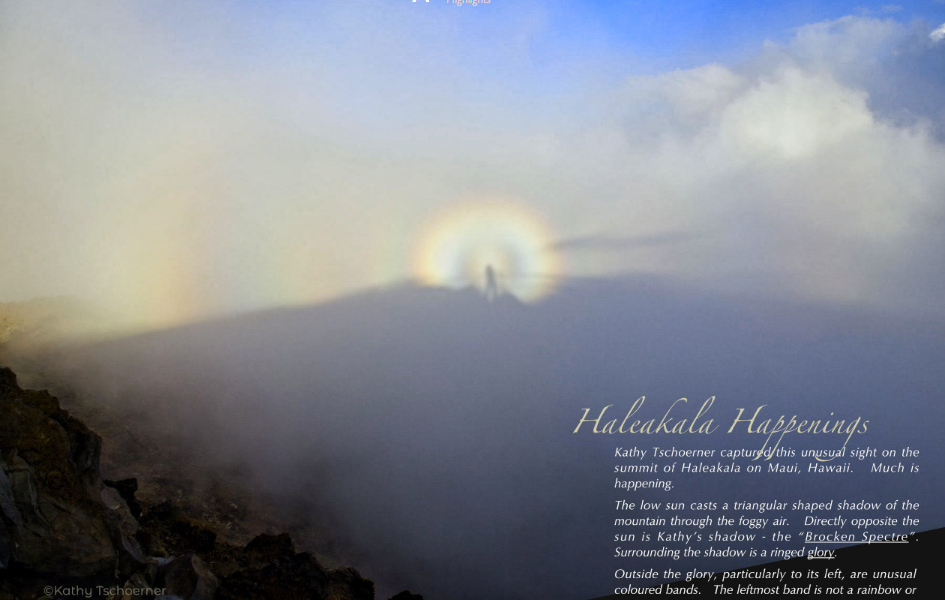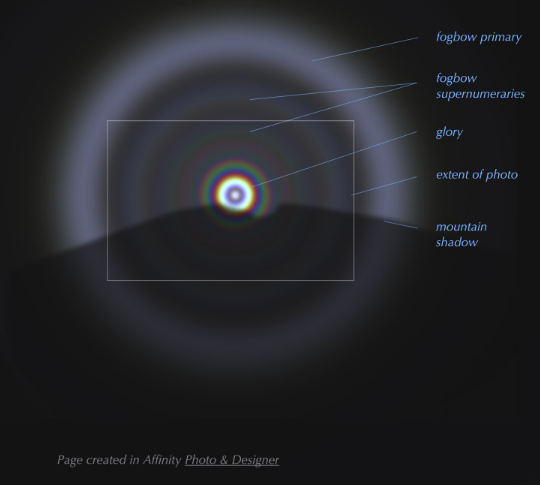Haleakala Happenings
Haleakala Happenings: Unveiling the Mysteries of Atmospheric Optics
The summit of Haleakala on Maui, Hawaii, never ceases to amaze with its atmospheric phenomena. Recently, photographer Kathy Tschoerner captured a mesmerizing sight that left experts in awe. As the low sun cast its rays through the foggy air, a triangular shadow of the mountain emerged, accompanied by a captivating display of optical wonders.
Opposite the sun, Kathy's shadow took on an ethereal appearance known as the "Brocken Spectre." This phenomenon occurs when the sunlight is scattered by tiny water droplets or ice crystals suspended in the air. The resulting shadow appears magnified and surrounded by a halo-like ring called a glory. But that was not all; there was something else happening in the sky.
Beyond the glory, peculiar colored bands caught Kathy's attention. Unlike rainbows or fogbows, which have their red hues on the inside, these bands displayed vibrant shades on the outside. This raised the question: What could be causing this unique phenomenon?
To unravel the mystery behind these colored bands, scientists turned to Mie-Lorentz simulations. By analyzing the photo and combining it with the camera lens data, they discovered that the leftmost red band was approximately 24° from the center of the glory. The brightness of the glory indicated the presence of fog droplets, which could also be responsible for creating a fogbow. Through calculations using different fog droplet sizes, researchers found that droplets measuring around 9 microns in diameter provided the best fit for the observed band positions.
These colored bands, it turns out, are fragments of fogbow supernumerary bows. Just like rainbows, fogbows can exhibit supernumeraries—additional bands of colors—though they are typically more vivid than those seen in regular rainbows. Unfortunately, the main fogbow was outside the camera frame, possibly concealed by the thin and patchy mist layer.
Apart from the Brocken Spectre and the shadow of the mountain, the entire spectacle was a result of the low sunlight diffracting through small fog droplets. The interaction between light and these microscopic droplets created a visual feast for those fortunate enough to witness it.
Atmospheric optics is a captivating field that unveils the secrets behind the stunning displays we observe in the sky. The phenomenon witnessed atop Haleakala highlights the intricate interplay between sunlight, fog droplets, and the surrounding atmosphere. As scientists continue to study and understand these phenomena, they deepen our appreciation for the wonders that unfold above us.
In conclusion, the Haleakala Happenings serve as a reminder of the beauty and complexity of atmospheric optics. The unique combination of a triangular shadow, the Brocken Spectre, a glory, and colored bands showcases the interplay between sunlight and fog droplets. Through meticulous analysis and simulations, scientists have unraveled some of the secrets behind this breathtaking display. As we continue to explore and learn about atmospheric phenomena, we gain a deeper understanding of our natural world and the marvels it holds.

Haleakala Happenings
Kathy Tschoerner captured this unusual sight on the summit of Haleakala on Maui, Hawaii. Much is happening.
The low sun casts a triangular shaped shadow of the mountain through the foggy air. Directly opposite the sun is Kathy's shadow the "Brocken Spectre". Surrounding the shadow is a ringed glory.
Outside the glory, particularly to its left, are unusual coloured bands. The leftmost band is not a rainbow or fogbow - they have reds outside. What then is it?

The Mie-Lorentz simulation at left (make your own using IRIS) reveals what is happening.
Measurements of the photo combined with its camera lens data show that the leftmost red band was about 24° from the glory's centre. The bright glory indicates that fog droplets were about and might also be creating a fogbow. Mie calculations for different fog droplet sizes
give a reasonable fit to the band positions with droplets 9 micron in diameter.
The colour bands are fragments of fogbow supernumerary bows. Fogbows have supernumeraries like those of rainbows and they are more strongly coloured than the main fogbow.
The main fogbow was outside the camera frame and possibly was not showing in the thin and patchy mist Layer.
Apart from the Brocken and mountain shadow, the whole display was made by the low sunlight diffracted by small fog droplets.

Note: this article has been automatically converted from the old site and may not appear as intended. You can find the original article here.
Reference Atmospheric Optics
If you use any of the definitions, information, or data presented on Atmospheric Optics, please copy the link or reference below to properly credit us as the reference source. Thank you!
-
<a href="https://atoptics.co.uk/blog/haleakala-happenings/">Haleakala Happenings </a>
-
"Haleakala Happenings ". Atmospheric Optics. Accessed on November 26, 2024. https://atoptics.co.uk/blog/haleakala-happenings/.
-
"Haleakala Happenings ". Atmospheric Optics, https://atoptics.co.uk/blog/haleakala-happenings/. Accessed 26 November, 2024
-
Haleakala Happenings . Atmospheric Optics. Retrieved from https://atoptics.co.uk/blog/haleakala-happenings/.